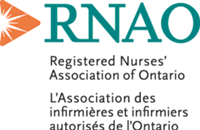Media Release: New nursing guideline aims to improve care transitions for patients
TORONTO, March 31, 2014 /CNW/ - Patients who require care in Ontario's health system are less likely to fall through the cracks if recommendations developed by registered nurses (RN) are adopted by health organizations such as hospitals, rehab facilities, long-term care homes, and home care agencies.
The recommendations are contained in the Care Transitions best practice guideline released Monday by the Registered Nurses' Association of Ontario (RNAO).
"The whole point of this guideline is to ensure that people continue to receive safe and effective care when they move from one part of the health system to another," says Brenda Dusek, the RN that supported the panel of experts that developed the guideline's recommendations.
Dusek says the potential for risk increases when patients move between health-care providers (eg. during shift changes), between units of the same organization and from one health organization to another (from a hospital to a nursing home).
The guideline outlines evidence-based recommendations for nurses and other members of the health team to ensure effective care transitions. They include an increased role for nurses on interprofessional teams, and more effective communication among team members, patients, their families and caregivers.
RNAO's guideline has recommendations that examine how nurses should change their practice to ensure a patient's needs are met before, during and after care transitions, as well as recommendations health organizations should implement to ensure quality care and patient safety.
"We know gaps in care can happen and these gaps can affect everything from the medications someone is prescribed to their physical and psychological needs," says Doris Grinspun, RNAO's chief executive officer, adding nurses can play a pivotal role by focusing on those transitions or points in a person's care. "We're confident that organizations that adopt the recommendations contained in this guideline will see increased patient satisfaction and higher quality care."
RNAO's Care Transitions BPG has already been endorsed by Accreditation Canada, the agency responsible for monitoring quality and safety among health-care organizations. The guideline is available online.
RNAO's Best Practice Guidelines Program is funded by the Ministry of Health and Long-Term Care, and was launched in 1999 to provide the best available evidence for patient care across a wide range of health-care settings. The 50 guidelines developed to date are a substantive contribution towards building excellence in Ontario's health system. They are available to nurses and other health-care professionals across Canada and abroad.
The Registered Nurses' Association of Ontario (RNAO) is the professional association representing registered nurses in Ontario. Since 1925, RNAO has advocated for healthy public policy, promoted excellence in nursing practice, increased nurses' contribution to shaping the health-care system, and influenced decisions that affect nurses and the public they serve.
For more information about RNAO, visit our website at http://www.RNAO.ca.
SOURCE: Registered Nurses' Association of Ontario

To arrange an interview with a nurse about this guideline or for more information, please contact: Marion Zych, Director of Communications, RNAO, Cell: 647-406-5605 / Phone: 416-408-5605, Toll free: 1-800-268-7199 ext. 209, [email protected]

Share this article